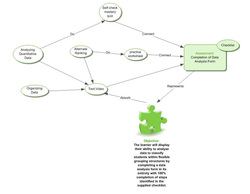|
Data, Data, Data introduces class participants to the variety of data that can be collected (qualitative vs. quantitative) from formative and summative assessments as well as practice with how to classify data in a meaningful structure to encourage data literacy and data driven differentiation. K. Dyer identifies data literacy (2014) as "knowing the different types of data available, which data to use for decision-making, evaluating the accuracy and sufficiency of the data to be used, transforming data into actionable information to guide decision making and communicating accurately about students learning". Therefore increased data literacy increases skills in offering adjusted instruction congruent to students' current need. One manner in which to differentiate is through flexible grouping structures, which are short-term, homogenous groups that offer narrowed instructional focus.
 Select image for magnified viewing. Select image for magnified viewing.
Class participants will integrate research, videos, and documents to become familiar with various types of data and their uses as well as participate within checks for understanding by organizing both quantitative and qualitative data using different techniques.
Creating connections between the learner and the content, the class participant will collect data (of their choice) from their own classroom to organize into a flexible grouping structure. They will be provided a fillable pdf form to record their data and determine their flexible groups. Flexibility and diversity within this activity has been integrated through the autonomy of data collection technique, data assessment to retrieve data, as well as the use of the fillable pdf form. This form was chosen for two reasons; 1) pdf files are cross-platform compatible and 2) they can be used as a reusable object as a job aid. Respecting students varying skills, the pdf file has been developed for ready-fillable fields that can be select using an arrow or the tab key. There form has been chosen and developed to reduce technology barriers for using the form so the participant can focus their efforts on data literacy skills more so than form manipulation. |
Your browser does not support viewing this document. Click here to download the document.
Select the rectangle icon (next to the magnifying glass in lower left corner) to view the document full screen.
A checklist will be used for this activity as the student learning objective (SLO) is for analyzing and classify data. Completing each section of the form will identify which data collection method was used, flexible grouping structures derived from the data, actionable instructional strategies based upon data as well as a reflection of the process. These components are reflected within the checklist.
Plagarism considerations are minimal with this activity as data will be retrieved from current students and the classification process will be unique to the data set used. | ||||||
Elaboration Theory (Reigeluth). (2015). Retrieved November 20, 2015, from http://www.learning-theories.com/elaboration-theory-reigeluth.html
Dyer, K. (2014, September 18). Data Literacy – What it is and How it Differs from Assessment Literacy. Retrieved November 22, 2015, from https://www.nwea.org/blog/2014/data-literacy-differs-assessment-literacy/
Dyer, K. (2014, September 18). Data Literacy – What it is and How it Differs from Assessment Literacy. Retrieved November 22, 2015, from https://www.nwea.org/blog/2014/data-literacy-differs-assessment-literacy/